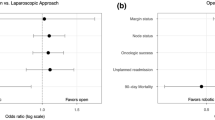Abstract
Background
Transanal endoscopic microsurgery (TEM) is a technically demanding key technique in minimally invasive rectal surgery. We investigated the learning curve of colorectal surgeons commencing with TEM.
Methods
All TEM procedures of four colorectal surgeons were analyzed. Procedures were ranked chronologically per surgeon. Outcomes included conversion, postoperative complications, procedure time, and recurrence. Backward multivariable regression analysis identified learning curve effects and other predictors.
Results
Four surgeons resected 693 rectal lesions [69.9 % adenoma/25.5 % carcinoma; median size 20 cm2; interquartile range (IQR) 11–35; 7 ± 4 cm ab ano]. A total of 555 resections (80.1 %) were histopathologically radical (R0). Conversion (4.3 %) was influenced by a learning curve [odds ratio (OR) 0.991 per additional procedure; 95 % confidence interval (CI) 0.984–0.998] and by lesion size. Postoperative complications depended only on the individual surgeon and lesion size in benign lesions (10.4 % complications). A learning curve (OR 0.99; 95 % CI 0.988–0.998) and peritoneal entrance affected complications in malignant lesions (13.3 %). Procedure time [median 55 min (IQR 30–90)] was influenced by a learning curve [B −0.11 (95 % CI −0.14 to −0.09)], individual surgeon, single-piece resection, peritoneal entrance, lesion size, and rectal quadrant. Recurrence of benign lesions (4.5 %) depended on lesion size, R0 resection, and prior resection attempts. Recurrence of malignant lesions (8.9 %) depended on 3D stereoscopic view, lesion size, full-thickness resection, and length of follow-up. Recurrence-free survival of patients operated during the 36th through 80th procedure per surgeon was significantly shorter than in patients operated during procedures 1–35 and 81 onwards.
Conclusions
A surgical learning curve affected conversion rate, procedure time, and complication rate. It did not influence recurrence rates, possibly due to evolving patient populations. This first insight into the learning curve of TEM stresses the importance of quality monitoring and centralisation of care.



Similar content being viewed by others
References
Buess G, Hutterer F, Theiss J, Bobel M, Isselhard W, Pichlmaier H (1984) A system for a transanal endoscopic rectum operation. Chirurg 55(10):677–680
Moore JS, Cataldo PA, Osler T, Hyman NH (2008) Transanal endoscopic microsurgery is more effective than traditional transanal excision for resection of rectal masses. Dis Colon Rectum 51(7):1026–1030
De Graaf EJ, Burger JW, van Ijsseldijk AL, Tetteroo GW, Dawson I, Hop WC (2011) Transanal endoscopic microsurgery is superior to transanal excision of rectal adenomas. Colorectal Dis 13(7):762–767
Maslekar S, Pillinger SH, Sharma A, Taylor A, Monson JR (2007) Cost analysis of transanal endoscopic microsurgery for rectal tumours. Colorectal Dis 9(3):229–234
Archampong D, Borowski D, Wille-Jorgensen P, Iversen LH (2012) Workload and surgeons specialty for outcome after colorectal cancer surgery. Cochrane Database Syst Rev 3:CD005391
Tekkis PP, Fazio VW, Lavery IC, Remzi FH, Senagore AJ, Wu JS, Strong SA, Poloneicki JD, Hull TL, Church JM (2005) Evaluation of the learning curve in ileal pouch-anal anastomosis surgery. Ann Surg 241(2):262–268
Pendlimari R, Holubar SD, Dozois EJ, Larson DW, Pemberton JH, Cima RR (2012) Technical proficiency in hand-assisted laparoscopic colon and rectal surgery: determining how many cases are required to achieve mastery. Arch Surg 147(4):317–322
Li JC, Lo AW, Hon SS, Ng SS, Lee JF, Leung KL (2012) Institution learning curve of laparoscopic colectomy: a multi-dimensional analysis. Int J Colorectal Dis 27(4):527–533
Koebrugge B, Bosscha K, Ernst MF (2009) Transanal endoscopic microsurgery for local excision of rectal lesions: is there a learning curve? Dig Surg 26(5):372–377
Kipfmuller K, Buess G, Naruhn M, Junginger T (1988) Training program for transanal endoscopic microsurgery. Surg Endosc 2(1):24–27
Winde G, Nottberg H, Keller R, Schmid KW, Bunte H (1996) Surgical cure for early rectal carcinomas (T1). Transanal endoscopic microsurgery vs. anterior resection. Dis Colon Rectum 39(9):969–976
Barendse RM, Doornebosch PG, Bemelman WA, Fockens P, Dekker E, De Graaf EJ (2012) Transanal employment of single access ports is feasible for rectal surgery. Ann Surg 256(6):1030–1033
Disclosures
Drs. Barendse, Bijnen, Consten, Hoff, Dekker, Fockens, Bemelman, and de Graaf, as well as Mr. Dijkgraaf and Miss Rolf have no conflict of interest or financial ties to disclose.
Author information
Authors and Affiliations
Corresponding author
Rights and permissions
About this article
Cite this article
Barendse, R.M., Dijkgraaf, M.G., Rolf, U.R. et al. Colorectal surgeons’ learning curve of transanal endoscopic microsurgery. Surg Endosc 27, 3591–3602 (2013). https://doi.org/10.1007/s00464-013-2931-6
Received:
Accepted:
Published:
Issue Date:
DOI: https://doi.org/10.1007/s00464-013-2931-6




